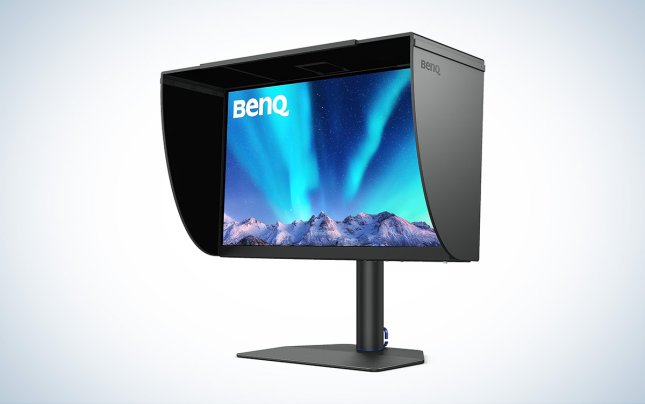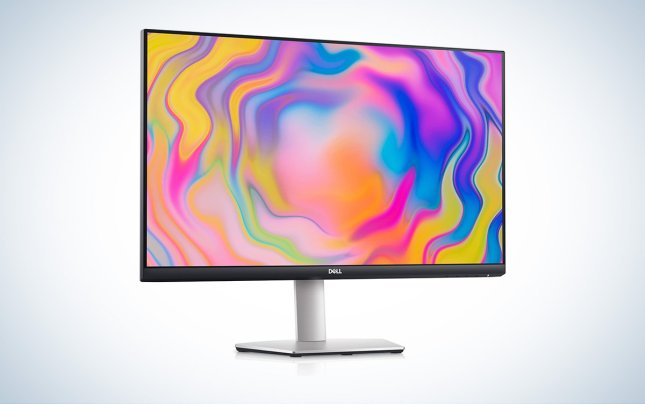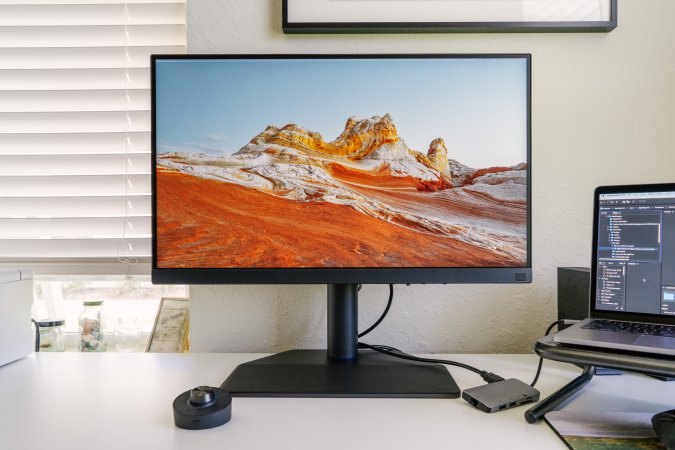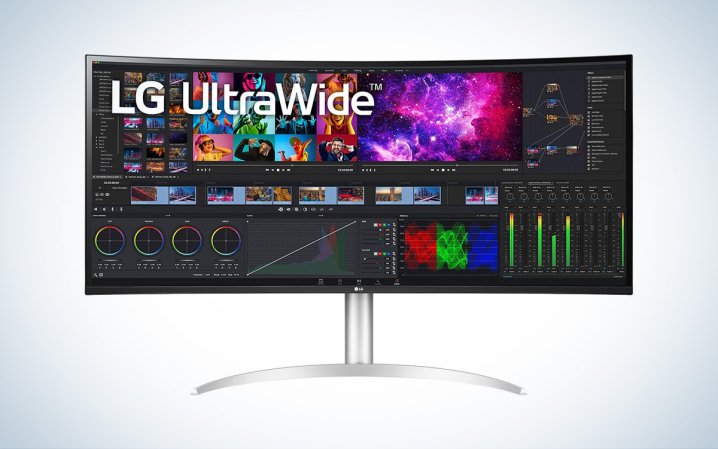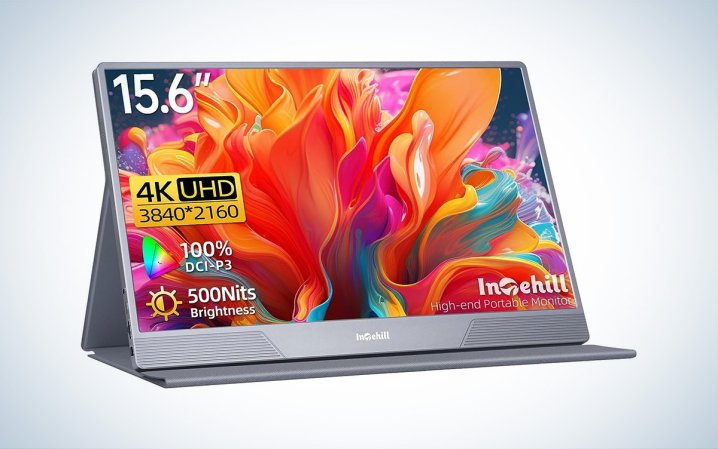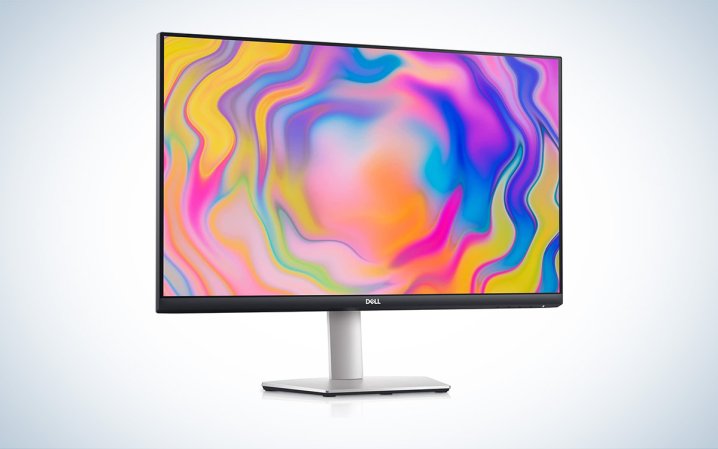We may earn revenue from the products available on this page and participate in affiliate programs. Learn more ›
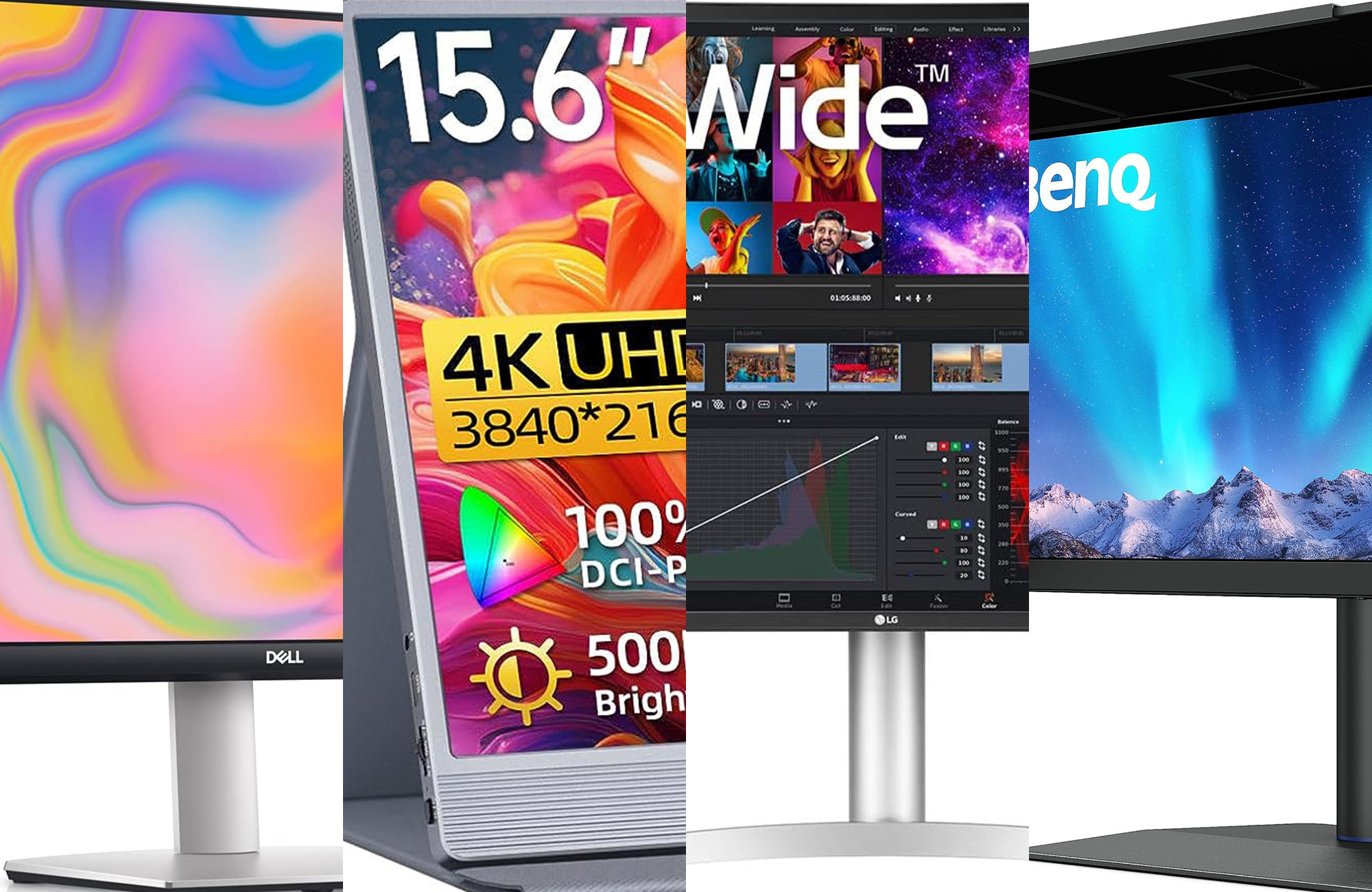
Monitors for video editing offer the color accuracy and resolution needed in order to get your raw footage looking polished and complete. Most consumer-focused monitors won’t cover the color range or contrast that video editing demands, leaving you with inconsistent and less polished results. The best monitors for video editing will help you streamline your editing process and allow you to put out consistent quality to keep clients or viewers coming back.
- Best overall: BenQ PhotoVue SW272U
- Best color accurate: Eizo ColorEdge CG319X
- Best ultrawide: LG 40WP95C
- Best portable: Intehill U15NA 4K Portable Monitor
- Best budget: Dell S2722QC
How we chose the best monitors for video editing
When selecting the monitors for video editing included in this guide, we prioritized color accuracy, resolution, screen technology, and connectivity options. As everyone has a different preference for display size, we aimed to choose a variety of options. It was also important to include a range of price points and features for video editors at every level. Finally, we have spent countless hours in front of screens editing videos and photos, which guided our decisions, along with editorial reviews and user feedback.
The best monitors for video editing: Reviews & Recommendations
Unfortunately, shooting your videos is just half the process. You’ll then need to spend time cutting all that content together, messing with audio levels and music, color grading, and more. But with one of these monitors for video editing, you’ll have an easier time tackling all that and be able to trust your results.
Best overall: BenQ PhotoVue SW272U
Best overall
BenQ PhotoVue SW272U
Pros
- Excellent color accuracy out of the box
- Plenty of connectivity options
- Adjustable stand is very sturdy
- Lots of features specific to editing
Cons
- Pricey
- No speakers
Specs
- Screen size: 27 inches
- Resolution: 4K (3840 x 2160 pixels)
- Color space coverage: 100% sRGB, 99% Adobe RGB, 99% DCI-P3
- Brightness: 400 nits
- HDR compatibility: HDR10, Hybrid Log Gamma
- Built-in speakers: None
BenQ is one of the top producers of monitors for creatives, including video editing. The SW272U earns our top spots because of its list of features specifically tailored to creatives and its impressive performance. It comes calibrated and tested for color accuracy right from the factory for Delta E ≤1.5 accuracy. A certification report even comes with the monitor. It covers 99 percent of DCI-P3, is Calman verified and Pantone validated, and offers 10-bit support for 1.07 billion colors. You can edit straight out of the box without fussing with monitor settings.
The 4K resolution will work well for even the most particular editors. I use this monitor in a room with south and west-facing windows and have no issues seeing my screen, thanks to the 400 nits of brightness. The monitor also comes with plenty of settings and features specific to creatives. That includes a P3 color preview to ensure accurate colors before you deliver a video to clients. For hybrid creatives needing to print photographs, the Paper Color Sync allows you to fine-tune color settings without burning through precious photo paper and ink.
In terms of ergonomics and build, this IPS monitor features an anti-glare coating to essentially eliminate reflections, making it more comfortable to look at for hours on end. It has a sturdy stand with plenty of adjustment options and a leatherette base. There aren’t any built-in speakers, but a 3.5mm headphone jack allows you to plug in headphones for audio adjustments. The included Hotkey Puck G3 makes it easy to change settings with shortcuts. It’s an expensive monitor, but it offers truly outstanding quality, a robust feature set for creatives, and excellent ergonomics for those long editing sessions.
Best color accurate: Eizo ColorEdge CG319X
Best color accurate
Eizo ColorEdge CG319X
Pros
- Superb color accuracy
- Built-in automatic color calibration
- 31.1-inch size offers lots of space
- Dual HDMI 2.0 and dual DisplayPort 1.2 connectivity
Cons
- Premium price tag
Specs
- Screen size: 31.1 inches
- Resolution: 4K (4096 x 2160 pixels)
- Color space coverage: 99% Adobe RGB, 98% DCI-P3
- Brightness: 350 nits
- HDR compatibility: Hybrid Log Gamma
- Built-in speakers: None
If money is no object and you want the best of the best, the Eizo ColorEdge CG319X is the way to go. It offers a larger 31.1-inch display size along with a higher resolution of 4096 x 2160. This results in a dense 149ppi (pixels per inch), which allows you to see fine details when video editing along with photo retouching. It features a contrast ratio of 1500:1 and a maximum brightness of 350 nits.
The ColorEdge CG319X also offers truly excellent color accuracy with 98 percent coverage of DCI-P3. But one of the best features of this premium monitor is the built-in calibration sensor. You won’t need to purchase a separate calibration tool, as the monitor contains everything necessary. It can even be set to automatically calibrate at designated times, keeping your work time free of that task.
As we would expect for one of the best monitors for video editing, the ColorEdge CG319X provides plenty of connectivity options, including dual HDMI 2.0 and dual DisplayPort 1.2 connectivity. There’s also one upstream and three downstream USB 3.0 ports. It comes with a monitor shade to help reduce glare, an ergonomic stand with a quick release, and a built-in carrying handle on the back of the monitor. It’s an expensive monitor, to be sure, but it offers a lot of quality and features that pro-level video editors demand.
Best ultrawide: LG 40WP95C
Best ultrawide
LG 40WP95C
Pros
- Excellent color accuracy
- Massive display size with 5K2K resolution
- Thunderbolt 4 support
- Includes an ambient light sensor
Cons
- Lower contrast and brightness don’t work well in bright rooms
Specs
- Screen size: 39.7
- Resolution: 5K2K (5120 x 2160 pixels)
- Color space coverage: 98% DCI-P3
- Brightness: 300 nits
- HDR compatibility: HDR10
- Built-in speakers: Yes, 2 x 10 W
Sometimes, bigger is better. Editing videos typically involves working with long timelines, and an ultrawide display will allow you to see more of that at once without compressing it to an unusable point. LG 40WP95C offers a massive 40-inch display size with a 21:9 aspect ratio. Despite the larger size, it maintains a 140ppi thanks to the 5K2K resolution, so you’ll still be able to see plenty of detail.
On top of excellent resolution, this LG monitor also provides highly accurate colors. It covers 98 percent of the DCI-P3 colorspace, so you can trust that your color grading will be spot on. It supports HDR10, resulting in vibrant color as well. Should you want to maintain accurate color, it is hardware calibration ready.
The LG 40WP95C offers numerous connectivity options, including Thunderbolt 4 with 96W power delivery. It supports daisy chaining, should you want an epic multi-monitor setup. The built-in ambient light sensor can automatically adjust the display’s brightness based on lighting conditions in your office, providing appropriate brightness at all times. However, this monitor for video editing won’t work well in very bright spaces, as it tops out at 300 nits of brightness and a 1000:1 contrast ratio. If you’re a fan of the classic editing cave-type setup, though, it will more than get the job done.
Best portable: Intehill U15NA 4K Portable Monitor
Best portable
Intehill U15NA 4K Portable Monitor
Pros
- Only 0.4 inches thick and 1.6 pounds
- 100% DCI-P3 coverage
- Plenty bright
- Can run off your laptop’s power
Cons
- Integrated stand can slide on smooth surfaces
Specs
- Screen size: 15.6 inches
- Resolution: 4K (3840 x 2160 pixels)
- Color space coverage: 100% DCI-P3
- Brightness: 500 nits
- HDR compatibility: HDR compatible
- Built-in speakers: Yes, 2 x 2 W
Many videographers travel a lot for their shoots, and bringing a full-size desktop monitor on your trips is far from ideal. But editing on a single, small laptop screen isn’t great either. The Intehill 4K Portable Monitor is a fantastic solution for those on the go, offering excellent quality in a highly compact and portable package. It is less than half an inch thick, so you can slide it into your laptop bag with your computer to bring along wherever you go.
This portable monitor offers a 4K resolution with 282ppi for plenty of detail while editing videos. It covers 100 percent of DCI-P3 color space, so you could even use this for precise color work. The 500 nits of brightness and 1000:1 contrast ratio result in a bright, vibrant screen even when working in bright locations.
Unlike many portable monitors, setup and connection is extremely easy with the U15NA. If you work from a laptop or iPad, you won’t need an external power source as it draws from those devices. It offers two USB-C ports and a mini HDMI port, comes with all the cords you’ll need, and even comes with a mini HDMI to full-sized HDMI adapter. You could even connect this monitor directly to your camera to use as a larger display when filming yourself, which makes recording videos on the go much easier.
Best budget: Dell S2722QC
Dell S2722QC
Best budget
Pros
- Affordable
- 350 nits of brightness
- Sharp 4K resolution
Cons
- Color coverage isn’t’ great
Specs
- Screen size: 27 inches
- Resolution: 4K (3840 x 2160)
- Color space coverage: 99% sRGB
- Brightness: 350 nits
- HDR compatibility: HDR support
- Built-in speakers: Yes, 2 x 3 W
Monitors for video editing are typically expensive, but the Dell S2722QC offers a much more affordable alternative. Despite the sub $400 price, it provides a 4K resolution with 163ppi for plenty of detail. The 350 nits of brightness is superb, allowing you to view this screen in bright rooms easily.
Of course, as a budget monitor, there are some sacrifices to keep the price low. The most significant issue is the less-than-robust color space coverage. It covers 99 percent of the smaller sRGB space but doesn’t support the newer and wider DCI-P3 color space. The HDR mode is also a bit lackluster. But it features two built-in speakers, an ergonomic stand, and plenty of connection options. If you are new to the world of video editing, this monitor will be a great option to get you started.
Things to consider when shopping for the best monitors for video editing
Monitors for video editing have a different set of requirements compared to a general monitor for web browsing or work. There are lots of techy terms and features mentioned with monitors in general, but that’s especially true in the world of purpose-built monitors. Below, you’ll find some of the most important things to look out for when choosing your monitor for video editing to help you sort through all the noise.
Display size
The best display size largely comes down to personal preference, but some factors can help guide your decision. On the more practical side, you’ll need to figure out how much room you have for a monitor. While it may be tempting to get the largest available, that could leave you with zero desk space for anything else (unless you invest in a monitor wall mount). How far away you’ll sit from the monitor also impacts what size may be best. If you like to sit really close to your screen, you’ll have to spend more time looking around the display to actually see everything you need to if you have a massive monitor.
For most people, 27 inches is a sweet spot of plenty of screen real estate without getting too large. However, if you want more room for long video timelines, a larger ultrawide may be the way to go.
Resolution
Resolution refers to the number of pixels on your screen. The more pixels, the more detail you’ll be able to see. What resolution you need comes down to what resolution your output will be and how important fine details are to you. 4K monitors are becoming more common and more affordable, which is why all of the models we’ve selected offer 4K resolution. However, they aren’t necessarily a requirement for video editing.
If you export your videos at 1080p or less, you can get away with a monitor with a resolution below 4K. But if you need to export 4K footage for clients or simply want high-production videos with precise color grading, a 4K monitor will be the way to go.
Screen technology
Without getting into the weeds regarding display types and screen technology, you’ll want to look for an LCD monitor with an IPS (in-plane switching) panel monitor for video editing. IPS monitors use aligned liquid crystals, which provide better color performance, consistent brightness across the entire screen, and wider viewing angles. That means that you’ll be able to get consistently accurate color from your display, though we’d still recommend regular calibration if you’re serious about color accuracy. You also won’t have to worry about overly dim or bright spots on the edges and won’t have any loss of contrast if you are looking at the display from an angle, both of which can make editing video more challenging.
Color accuracy
Color accuracy is one of the most crucial components of any monitor for video editing and photo editing. In fact, it’s the main factor that makes these monitors stand out from general, consumer-focused models. In order to maintain accurate colors, you’ll want your monitor to offer wide color gamut coverage; the closer to 100 percent, the better. For video editing, look for at least 95 percent coverage of the DCI-P3 color space in particular. You will likely also see sRGB, Rec .709, and Rec. 2020 mentioned in the specs sheets. sRGB and Rec.709 are not as wide as other color spaces, so 100 percent coverage is common on high-quality monitors.
Speakers
If you’re editing video, chances are you’re also working with audio. For those connecting laptops to their monitors for video editing, speakers built into your monitor may be irrelevant. However, if you’re working from a desktop computer without speakers, you’ll need some way to hear the sound of your films.
While the speakers built into monitors won’t match the quality of the best desktop or powered speakers, it will save you money as you build out your setup. Not all monitors have built-in speakers, though, so be sure to pay close attention if you need that in your model.
Connectivity
The last piece of the monitors for video editing puzzle is how you’ll actually connect the display to your computer. Monitors will offer different connectivity options, including some combination of HDMI, Thunderbolt, DisplayPort, or USB-C. If you don’t want to use an adapter or hub, you’ll want to pick a monitor that can connect directly to your computer. For MacBooks, that means USB-C connectivity. Most PCs will work with HDMI or DisplayPort options.
FAQs
LCD monitors with IPS panels are the best option for video editing. That’s because they offer faster response times, wider viewing angles, and better color accuracy and contrast than other types of monitors.
The best monitor size for video editing simply comes down to personal preference. It is in part dictated by how much room you have for a monitor, how close you sit to your monitor, and how much screen real estate you want. For most, 27-inch displays are the ideal size, though some prefer a larger screen to display more of the video timeline at once.
You do not necessarily need a 4K monitor for video editing. In fact, for some, the 4K resolution is overkill and may not be worth the inherently higher price tag. However, 4K monitors are becoming more affordable and more common, making them more approachable for a wider audience. They do offer better levels of detail, which may be important depending on what types of videos you are editing. All of the monitors that we’ve included in this guide offer 4K resolution as a result, but that’s not to say that you can’t edit video on monitors with lower resolution.
Whether flat or curved is better depends on your display size and personal preference. If you opt for a large display, a curved monitor will offer better ergonomics, making it more comfortable to sit in front of your screen editing hour after hour. It will also result in better viewing angles, resulting in more consistent brightness and contrast across the entire screen. However, with smaller displays, such as a 27-inch screen, a curved display isn’t necessary.
Final thoughts on the best monitors for video editing
- Best overall: BenQ PhotoVue SW272U
- Best color accurate: Eizo ColorEdge CG319X
- Best ultrawide: LG 40WP95C
- Best portable: Intehill U15NA 4K Portable Monitor
- Best budget: Dell S2722QC
As with most things, there isn’t necessarily a one-size-fits-all monitor for video editing. Every video editor comes to the desk with slightly different needs and priorities, not to mention different skill levels and budgets. But no matter what, the best monitors for video editing will offer superb resolution for clearly seeing details, accurate colors, plenty of brightness, and an ergonomic stand to help you stay comfortable during those marathon editing sessions.
